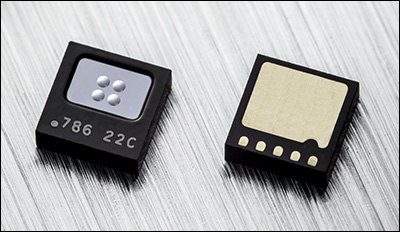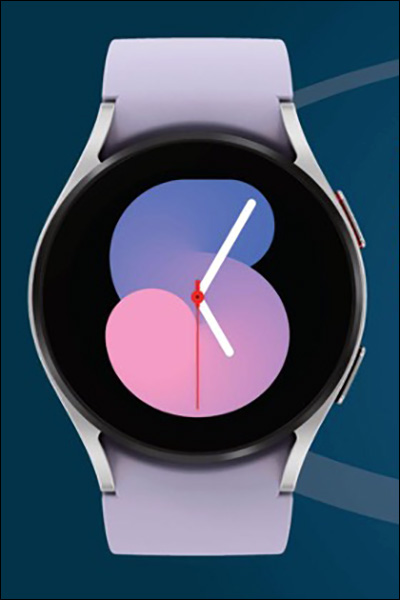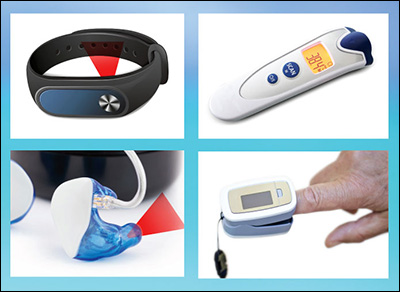Apr 14, 2023RFID Journal LIVE! 2023 will feature end-user companies discussing RFID's use in various industries, as well as exhibitors offering tagging solutions for multiple applications. To learn more, visit the event's website.
Samsung is adding temperature-based sensing functionality to its recent family of wearables, with a new IC provided by Melexis Microelectronic Integrated Systems. The small sensor, known as the MLX90632, can capture an individual's skin temperature without making contact with the skin, using far infrared (FIR) technology. Samsung says it is the first to release a product leveraging the technology, in its Galaxy Watch5 and Watch5 Pro models. The wristbands capture temperature within 0.2 degrees Celsius, and can then calculate a woman's fertility status, which is displayed in real time, as well as share it with health apps based on a user's Bluetooth connection.

The MLX90632 sensor
Melexis is an IC company that designs and manufactures integrated semiconductors, sensor ICs and programmable sensor IC systems, predominantly for use in the automotive industry. It has a ubiquitous presence in vehicle systems around the world, with 18 Melexis chips built into every car. Recently, the company has been pursuing solutions for the healthcare wearables market, using miniaturized sensor technology focused more on human health. Businesses that provide wearable devices have been striving to find a medical-grade technology capable of tracking temperatures reliably and in a small form factor, Melexis reports.
Temperature readings can be used to predict a wide variety of health conditions, ranging from infections or potential over-heating to fertility. However, temperature-based data capture has posed a challenge. Most wearable temperature sensors require firm contact with skin to capture an accurate reading, according to Joris Roels, Melexis's marketing manager. Otherwise, when not in contact with the skin, the sensor will measure the temperature of the surrounding air rather than the skin. However, the tight fit requirements mean that real-life applications when watches or devices are not in contact with the skin can prove unreliable.
Achieving Small Size with Contactless Sensor
Non-contact temperature sensing relies on detecting energy in the infrared wavelength region, Roels explains. The human skin, like every object, emits energy that can be measured to calculate its temperature. FIR sensors can accomplish reliable readings, he says, though as sensing devices become smaller, they become more susceptible to the impact of thermal shocks. That can lead to thermal noise and measurement errors.

Samsung's Galaxy Watch5

Joris Roels
FIR sensors have relied on TO-cans, metal packages in which sensors can be inserted to provide greater stability, but Melexis says these are too large for wearable devices. Therefore, the company created a product that works in a surface-mount package without the TO-can, while still accomplishing stable readings. That makes it possible for it to measure only 3 millimeters 3 by millimeters by 1 millimeter (0.1 inch by 0.04 inch by 0.04 inch), Roels says, and for it to be non-contact-based.
There are two versions of the sensor, one that offers medical-grade accuracy of plus or minus 0.2 degrees Celsius, and a consumer-based system with 1-degree accuracy. The IC includes the sensor element, signal processing, a digital interface and optics so that it can be inserted into wearables like watches, as well as into health-monitoring devices, such as portable diagnosis tools for continuously monitoring body temperatures. Monitoring vital signs repeatedly is a key enabler of preventive medicine practices for the purpose of early detection.
Wearables capable of measuring skin temperatures will provide new, reliable data related to health and wellbeing based on temperature levels, the company predicts. Scientific literature has suggested a person's skin temperature, in conjunction with other vital signs, can indicate such conditions as stress, sleep quality, infections, or (for women) menstrual cycles and potentially fertility. The IC could be built into smart glasses or earbuds, as well as forehead or ear thermometers used to take temperatures of individuals when they enter a healthcare facility. In addition, the chip could be built into portable blood-diagnosis tools, such as oxygen scanners.
Future Applications from Livestock to Employee Health
Beyond human wearables, the sensor allows a variety of potential applications, Roels says. "The fact that it is so small makes it valuable for other things," he states. Some of these other options include livestock health monitoring. For example, the sensor could be built into an ear tag worn by cattle. The tag could track temperatures reliably in conditions that have been challenging for sensors in the past. According to Melexis, the sensor is unlikely to be in touch-contact at all times with an animal's skin.

The sensor allows a variety of potential applications.
With a wireless connection (such as Bluetooth) to a mobile device, using RFID technology, data could be collected regularly so that farm managers could view potential health conditions, such as an animal becoming sick or entering a fertile state. The system could integrate other sensors, such as accelerometers, to view an animal's activity and compare that data against its temperature. This would enable users to confirm whether there was an issue, and if a particular cow might need to be separated from others.
Moreover, the sensors could be built into wearable devices that track the conditions of human workers whose circumstances make them vulnerable to heat, such as those who conduct work outside in warm climates. The device could identify if an individual might be too hot, and the data is transmitted to a server, where it can be viewed and alerts can be sent, so that the person could be instructed to find shade or stop working.
Because of its small size and contactless properties, the technology could be used in smart building deployments, for which typical sensors might not fit. It could also be used for appliances, such as hair dryers or cooking implements. "Temperature is a parameter which is used in many different applications," Roels notes. Melexis says it will continue to move into new sectors with its technology, which could include alternative mobility such as ebikes, as well as smart appliances, robotics, energy management and the digital health space.
Key Takeaways:
- Samsung's Galaxy Watch5 family will be the first products to take advantage of Melexis's new contactless temperature-sensing ICs designed for digital health management.
- Over time, Melexis expects its MLX90632 sensor technology to be adopted in a variety of applications that include livestock management and smart buildings.

